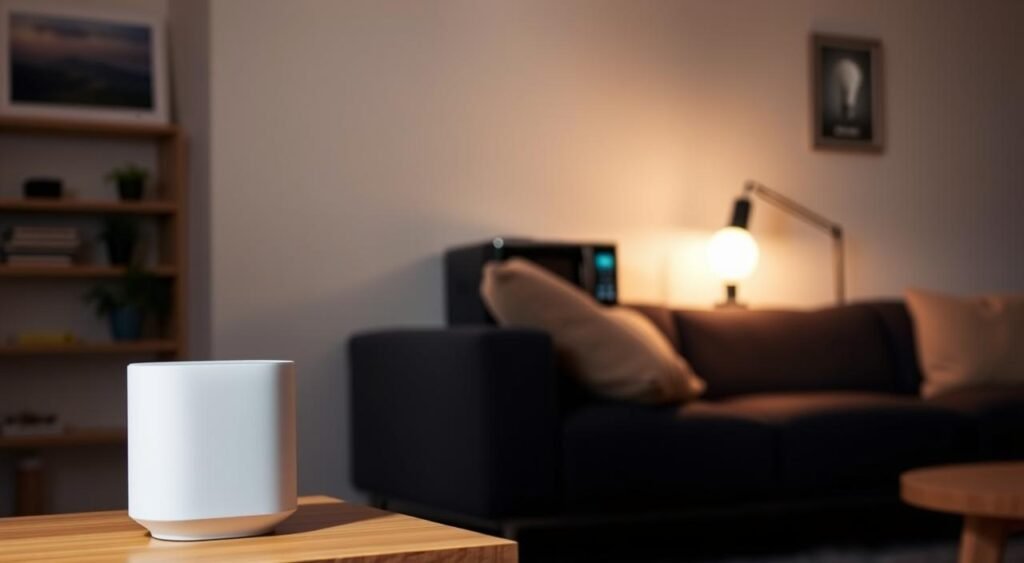Imagine a smart home that doesn’t empty your wallet. Home automation on a budget is not just possible—it’s achievable. Think about smart lights, voice-controlled thermostats, and security cameras that won’t break the bank. With smart choices, you can enhance your home without sacrificing style or practicality. Budget-friendly tech like TP-Link Tapo bulbs or Amazon Smart Plugs shows you can enjoy modern conveniences without financial strain.
Let’s face it: setting up a smart home can start under $500. Picture this: dimming lights with a tap, locking doors remotely, or adjusting the heat from bed—all on a budget. This guide will show you how to focus on essential features, avoid overspending, and take advantage of rebates or multi-pack deals. Even entry-level devices like the tado° Starter Kit or Raspberry Pi projects offer significant benefits at minimal costs.
Key Takeaways
- Smart home automation on a budget starts with identifying core needs like lighting or security.
- Low-cost devices like TP-Link bulbs or Amazon Smart Plugs cut energy use while boosting convenience.
- Phased upgrades using compatible brands (like Alexa or Google Assistant) prevent overspending.
- DIY projects with Raspberry Pi or free apps like Home Assistant keep costs down without sacrificing function.
- Thermostat rebates and affordable sensors maximize savings without premium-priced systems.
Understanding the Smart Home Revolution
Ever wondered if smart home tech is just for the wealthy? Think again! Affordable smart home solutions are changing how we live. Brands like Smartify offer devices starting at under €10, making the revolution accessible to all. Let’s explore how to embrace automation without breaking the bank.
Why Home Automation Doesn’t Have to Break the Bank
Here’s the truth: entry-level smart devices work wonders. Smartify’s plugs and bulbs start at €5—no six-figure budget needed. Their 24/7 delivery and free shipping over €65 make starting easy. Plus, energy-efficient picks like their bulbs slash utility costs.
Did you know smart thermostats alone cut heating bills by 10-12%? That’s savings, not spending!
The Real Benefits of an Automated Home
Automation’s perks go beyond luxury. Let’s break it down:
| Benefit | Example |
|---|---|
| Energy Savings | Smart plugs turn off devices remotely |
| Security Boost | Budget cameras with motion alerts |
| Time Efficiency | Google Assistant voice controls |
Setting Realistic Expectations for Budget Automation
Start small. Prioritize needs over wants—like security first, then entertainment. Scalable systems grow with your budget. Avoid buying incompatible devices; stick to ecosystems like Alexa or Google Home.
And yes, that old TV? Smart plugs can make it “smart” overnight. No need to replace everything!
Planning Your Home Automation on a Budget
Let’s get practical—planning your budget-friendly home automation starts with clarity. As someone who’s helped hundreds of homeowners avoid overpaying, I’ll walk you through three steps to maximize your budget without sacrificing results. No guesswork here—just smart choices.
Identifying Your Automation Priorities
First, list your must-haves. Ask: “What problem do I want to solve?” Maybe it’s locking doors remotely with an August Smart Lock or cutting energy bills with TP-Link Kasa Smart Bulbs. Use this priority checklist:
- Security: Prioritize affordable cameras like Wyze Cam v3
- Convenience: Start with smart plugs ($10–$20 each) to automate lamps or fans
- Entertainment: Use voice commands via Amazon Echo Dot for media control
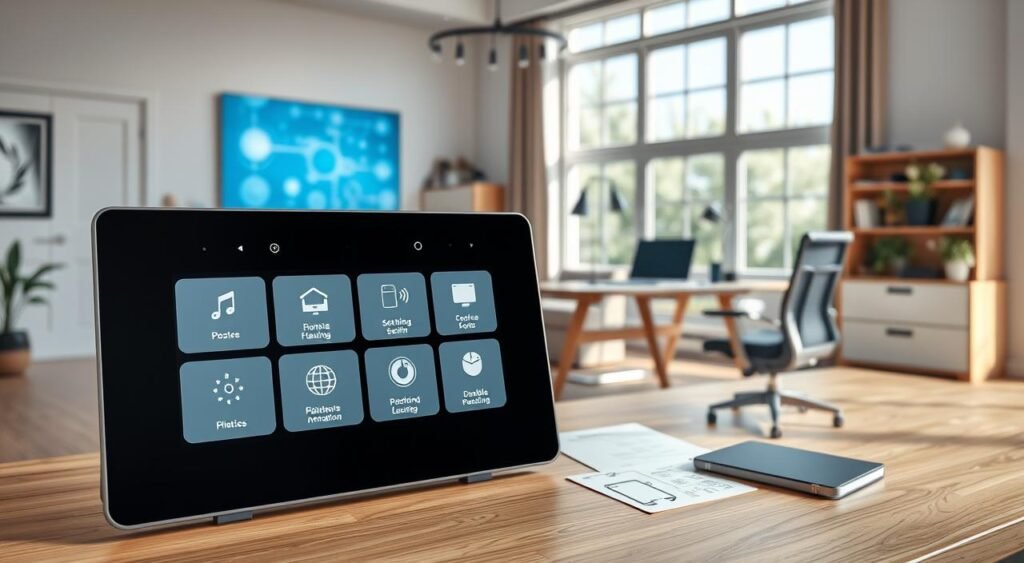
Creating a Phased Implementation Strategy
Spread investments over time. Phase 1 could be a hub (Google Nest Hub) plus 2–3 smart plugs. Phase 2 adds lighting or security. Use IFTTT to link devices for free automation—like turning on lights when your Wyze Cam detects motion. Need a visual? Here’s how it stacks up:
| Phase | Devices | Cost Range |
|---|---|---|
| Phase 1 | Hub + 3 plugs | $50–$100 |
| Phase 2 | Smart lights/security | $150–$300 |
| Phase 3 | Advanced sensors/voice assistants | $200–$400 |
Calculating the Return on Investment
Not all devices are equal. A $30 smart plug that turns off unused appliances can save 10–15% on energy bills. Even better? Smart locks or cameras boost home value—studies show Wyze Lock upgrades add $500–$1,000 to resale value. Track savings with this simple formula:
Cost of device ÷ Annual energy savings = Years to break-even point
My clients saved 20% on utilities by pairing smart bulbs with motion sensors. Ready to turn “someday” into “today”? Let’s get started!
Essential Budget-Friendly Smart Home Hubs
Your smart home’s brain doesn’t have to cost a fortune. Let’s explore hubs that power low-cost home automation without sacrificing control or compatibility.
The Amazon Echo Dot (5th Gen) is a great starting point at just $49.99. It offers voice control and a built-in Wi-Fi router. For those needing to manage multiple devices, the Wyze Hub v2 ($49.99) is ideal. It supports over 200 devices and works well with cameras like the Wyze Cam v3. Apple enthusiasts will appreciate the Aqara Smart Hub M2 ($59.99), which integrates with HomeKit and supports Zigbee devices.
“Compatibility is key—pick a hub that plays well with your existing gadgets!”
Opt for Z-Wave or Zigbee protocols for better range and reliability. Open-source options like Home Assistant are cost-effective, running on a Raspberry Pi for under $50. While pricier options like the SmartThings Hub offer advanced features, starting small and expanding over time is a viable option.
Consider your priorities: ecosystem flexibility or cost? The Google Nest Mini integrates with Chromecast for media, while budget-friendly options like Homey allow for custom routines. Avoid closed systems that limit you to one brand’s pricing.
Choose your foundation wisely—it’s the key to a smarter, more connected home without breaking the bank.
Affordable Smart Lighting Solutions
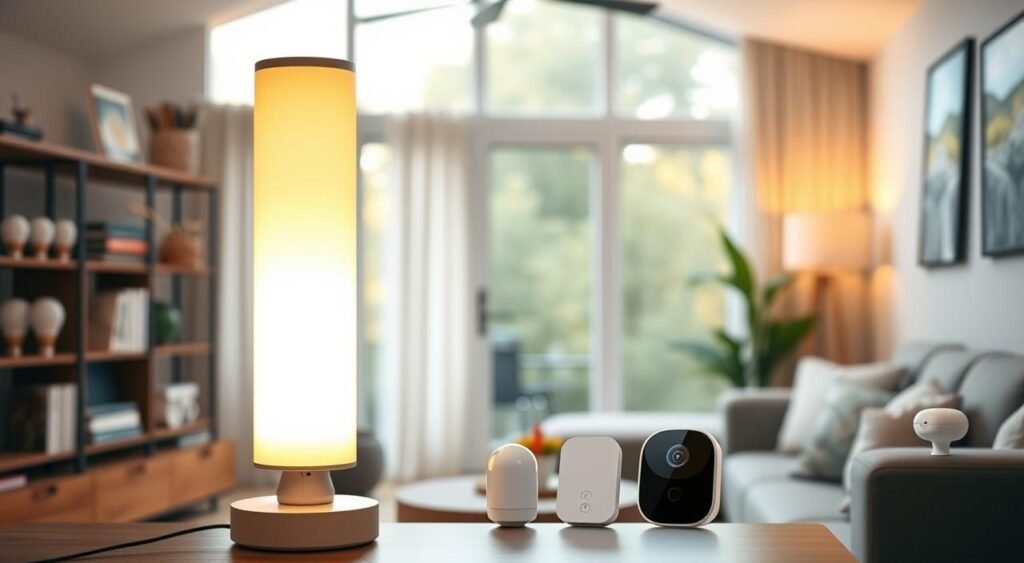
Lighting is the simplest way to enter the smart home world without breaking the bank. Even a few economical smart home devices like bulbs or switches can change your space. For example, Govee’s Wi-Fi LED Bulbs cost under $10 and work with Alexa or Google Home. The $20 Wiz Tunable White Bulb adjusts color temperature, simulating sunrise. These options are not just budget-friendly; they also sync with your daily routines.
Outdoor sconces with dimmable fixtures can slash energy bills by 20-30%, while boosting curb appeal. Imagine porch lights that flicker to life when guests arrive—without a hefty price tag.
Confused about bulbs vs. switches? Let’s break it down:
- Smart Bulbs (like Philips Hue White Floodlights at $1,200 lumens) work great for renters or small setups. Swap a bulb, and you’re done in minutes.
- Smart Switches (e.g., TP-Link Kasa at $15) cost a bit more upfront but pay off if you’re retrofitting multiple fixtures. They also save time—no bulb swapping!
DIY hacks? Absolutely. Pair Nanoleaf Matter Essentials strips ($60) with voice commands for under-cabinet lighting. Or repurpose Govee Curtain Lights ($30) as accent strips—check out this guide for clever placement ideas. Even a $7 Roku Smart Bulb SE adds color without burning a hole in your wallet!
Energy savings are real. Automated schedules cut waste—imagine your porch lights dimming at dawn automatically. Many bulbs use 80% less energy than incandescents. Over time, those savings add up, making these economical smart home devices a no-brainer.
Low-Cost Home Security Automation
Protecting your home doesn’t need a high-end budget. With cheap home automation technology, you can create a strong security system with smart devices under $200. Begin with affordable choices like Wyze Cameras ($25-$50) or Eufy’s doorbells ($80-$100). They offer HD video, motion detection, and app alerts.
- Smart locks from cheap home automation technology brands like August Smart Lock (starts at $99) allow remote access management.
- Motion sensors from Etekcity (under $30) work with Alexa/Google Home for immediate alerts.
- Reusing old smartphones? Transform an old iPhone into a security camera with apps like iSpy or MotionEyeOS—no extra hardware needed!
“Safety shouldn’t be a luxury—it’s a right everyone deserves.” — Smart Home Security Advocates
Pair motion-activated lights (like LIFX or Philips Hue bulbs) with sensors to deter intruders. For an added deterrent, use Wi-Fi plugs ($15-$25) to simulate TV activity. Opt for self-monitored systems like Cove ($19.99/month) or Frontpoint’s DIY setups starting at $69 to avoid costly monitoring contracts.
Combining a Wyze Cam V4 Pro ($50) with SimpliSafe’s affordable sensors ($249.96 starter kit) provides 24/7 coverage. ADT’s self-install options ($269) and abode’s starter packs ($139.99) offer professional-grade features without the high cost. Door/window sensors are key—stopping 90% of break-ins before they occur.
My top hack? Use free apps like IFTTT to automate alerts when motion sensors detect activity. This simple step brings significant peace of mind without a high budget. Every dollar spent on cheap home automation technology enhances security without sacrificing style or practicality.
Budget-Friendly Smart Thermostats and HVAC Controls
Ready to cut your energy costs without breaking the bank? Smart thermostats are the hidden gems of cost-effective home automation. You don’t have to spend a fortune to get started. Discover how to save with affordable tech that works as hard as you do.
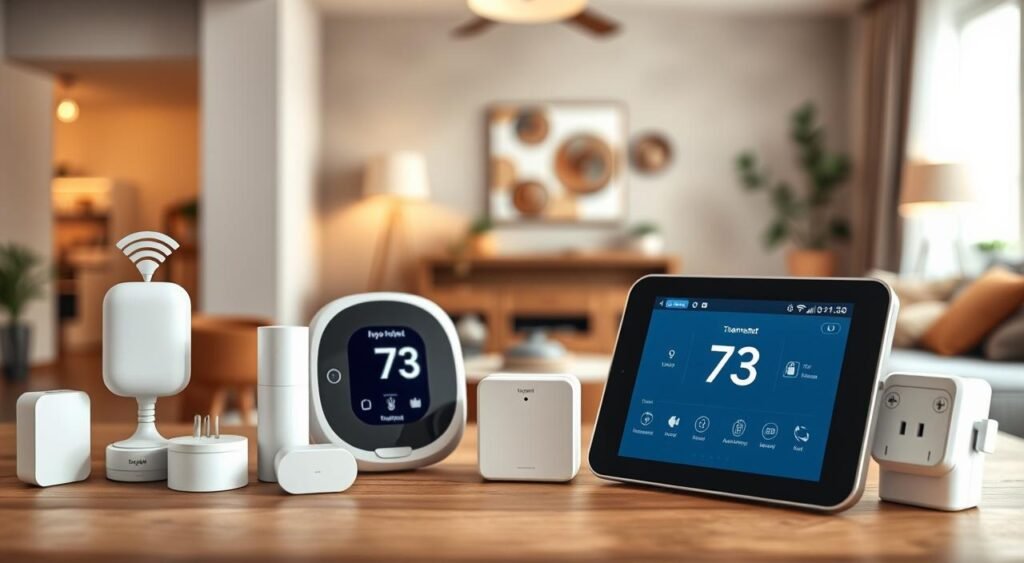
Begin by repurposing an old smartphone. Use free apps like OpenTherm to turn it into a remote sensor. It monitors room temperatures and alerts your main thermostat. No need for new hardware!
- Amazon Smart Thermostat: $60–$80 for Alexa fans—great for simple systems but skip if you use Google or Apple.
- Emerson Sensi ST55/ST75: Starts at $100, works without a C-wire, and adds color screens for $30 more.
- Honeywell T9: Multi-room sensing for $150+—perfect if your family argues over “just one more degree!”
Smart programming is essential. Set geofencing so your HVAC switches off when you leave. Imagine your heat turning down automatically when your phone exits the driveway. And don’t forget rebates! Many utilities offer $50–$150 back on models like Nest—sometimes making premium picks free. Even basic scheduling (like lowering temps while you’re at work) can cut 10–15% off yearly bills. No coding needed—just a little planning!
Need a C-wire adapter? They’re under $30 at Home Depot. And hey, if you’re into DIY, try the $26 Nest Ecosystem Adapter for extra sensors. Every dollar saved here pays for itself in energy savings. Ready to turn your home into a climate-smart fortress? Start small and watch your wallet—and the planet—thank you.
Economical Smart Home Entertainment Options
Transform your living space into a tech-savvy entertainment zone without overspending! These budget smart home gadgets prove that premium fun doesn’t require a premium price tag. Let’s explore how to turn your TV, music, and ambiance into a seamless experience—all while keeping your wallet happy.
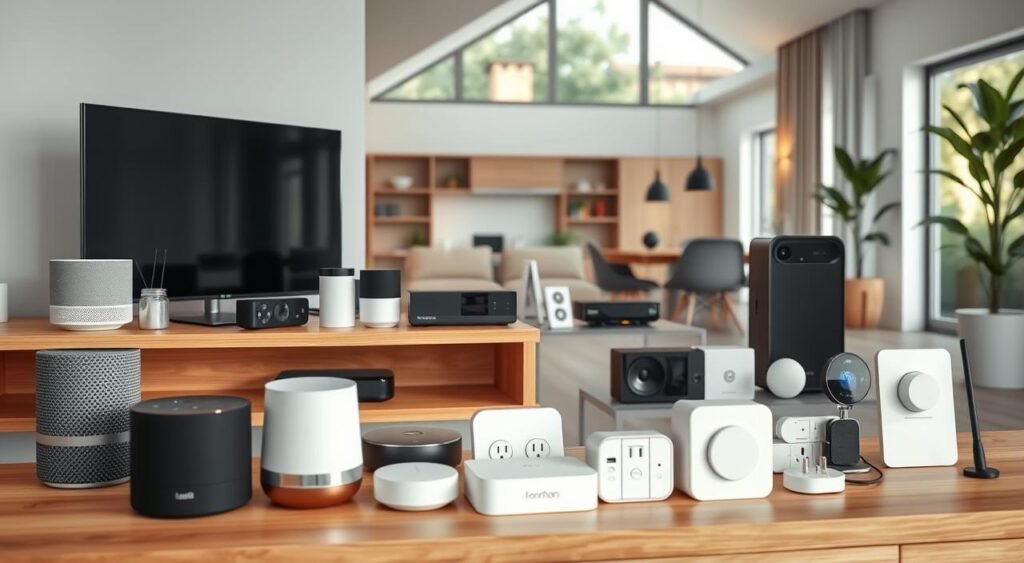
“Entertainment automation adds that ‘wow factor’ without the wow-worthy price!”
Multi-Room Audio Made Easy
Sync sound across rooms with these smart strategies:
- Cluster Amazon Echo Dots or Google Nest Minis for whole-home audio—pair them via voice commands.
- Upgrade Bluetooth speakers with TP-Link Kasa Smart Plugs ($23.99)—schedule music to start when you walk in the door!
- Use Philips Hue White Ambiance bulbs ($14.99) to match your movie night with dimmed lighting.
Stream and Save with Smart TV Hacks
Turn any TV into a smart hub using these tricks:
- Plug in a Roku Streaming Stick ($39.99) or Amazon Fire Stick—stream apps like Netflix and Hulu instantly.
- Pair a $60 LG SoundBar with voice commands compatibility for cinematic sound without the theater cost.
- Automate your setup: Use an Amazon Echo Dot ($49.99) to dim lights and drop shades with a voice command like “Movie Time!”
| Product | Price | Feature |
|---|---|---|
| Amazon Echo Dot | $49.99 | Voice control for music, lights, and more |
| Philips Hue White Ambiance Bulb | $14.99 | Adjustable white light temperatures |
| TP-Link Kasa Smart Plug | $23.99 | Wirelessly control non-smart devices |
Prime Day and Black Friday are golden opportunities—grab deals on budget smart home gadgets like the Echo Dot or budget soundbars. Mix and match these tools, and your living room will feel like a luxury retreat—all while sticking to your budget. Let’s make every movie night, game night, or cozy evening feel like a splurge without the splurge!
Kitchen Automation That Won’t Empty Your Wallet
Transform your kitchen into a smart hub with affordable automation systems that fit any budget! Turn everyday tasks into seamless routines without spending thousands. Imagine your coffee maker brewing before you wake up or your slow cooker shutting off automatically—all for under $50.
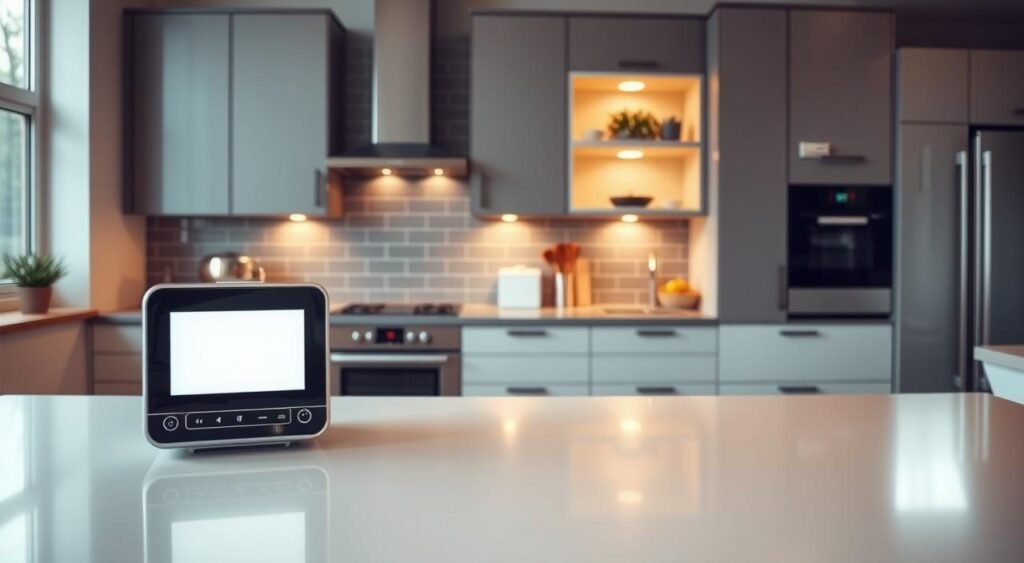
Start with smart plugs—they’re the secret sauce! Plug one into an outlet, and suddenly your toaster, blender, or kettle becomes “smart.” Set schedules via app or voice, like “Hey Google, turn on the coffee maker at 6:30 AM.” These tiny devices cost just $15–$30 and work with any appliance.
- Voice Assistants: Add a $30 Echo Dot or Nest Mini for hands-free cooking. Ask for recipe conversions, set timers, or play music—all while your hands are covered in dough.
- DIY Smart Alerts: Attach a magnetic sensor to your fridge. When you open it, get a notification to restock milk—no more last-minute trips! Pair it with a $10 sensor and free app.
| Device | What It Does | Price |
|---|---|---|
| Smart Plug | Control appliances remotely | $15–$30 |
| Motion Sensor | Automate under-cabinet lights when you enter the kitchen | $20 |
| Smart Speaker | Voice control for music, timers, and device management | $30–$50 |
Pair these with practical gadgets like the Bulfyss Bamboo Cutting Board ($15) or the Milton Pro Cook Set ($40), non-stick pans that fit induction stoves). These affordable upgrades blend style with function. Even small steps like scheduling your toaster save time and energy!
Remember: affordable automation systems don’t need fancy gadgets. A $20 smart plug can start your coffee before your feet hit the floor. Let’s make your kitchen smarter—without the luxury price tag!
DIY Smart Home Projects Under $50
Ready to transform your home into a smart haven without spending a fortune? These home automation on a budget projects offer significant results at a low cost. Plus, they’re simple enough to complete in just a weekend.
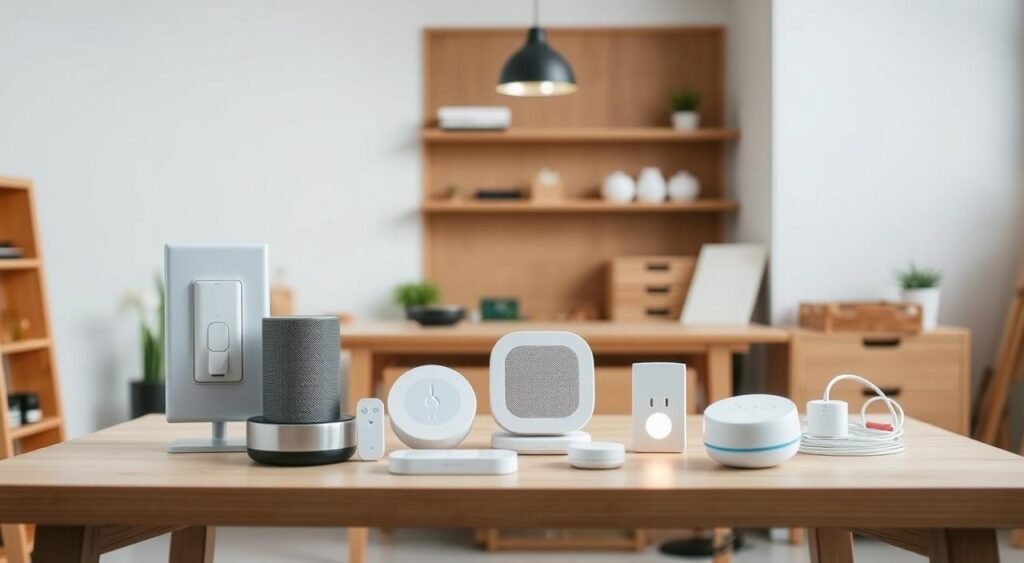
- Raspberry Pi Smart Speaker: Convert a $35 Raspberry Pi into a voice-controlled speaker with Moode Audio. Add a USB mic and speaker for under $50 total.
- RFID Door Lock: Secure entryways with a swipe using an Arduino board and RFID reader ($25-$40). No drilling needed!
- Motion-Activated Nightlights: Pair PIR sensors with LED strips ($20-$30) for automatic pathway lighting when you walk by.
No coding? No problem! I’ve created no-code setups using IFTTT and Alexa Routines. These connect devices like Kasa Smart Plugs ($25) to automate tasks, such as “lights on when the door opens.”
Get creative with what you already own! Turn an old smartphone into a security camera with Wyze Cam’s free app. Or repurpose Bluetooth speakers into voice-controlled devices using Google Assistant on a Raspberry Pi. Every dollar spent here boosts your home automation on a budget capabilities.
Pro tips to maximize savings:
- Avoid subscription-based systems—stick to free platforms like OpenHAB.
- Buy components separately: Kasa Smart Bulbs ($30 for 4) cost half of bundled kits.
- Score deals on Amazon Prime Day or Black Friday—Raspberry Pis often drop to $30.
These projects are not just affordable; they’re also clever. Start small, scale smart, and watch your home transform into a tech-savvy space without financial strain. Your future self will appreciate it!
Cost-Effective Voice Assistants and Control Options
Imagine controlling your lights, checking the weather, or playing music—all with your voice. Voice assistants are at the core of affordable smart home solutions. Today, they offer surprising power. Start with Amazon’s Echo Dot ($99) or Google Nest Mini—both fit anywhere and work with thousands of devices.
The Echo Dot’s room temperature sensor pairs perfectly with Eero routers for seamless connectivity. The Nest Mini’s improved mics pick up commands from across the room, even with background noise.
- Amazon Echo Dot: Alexa-powered, works with Philips Hue lights and security cameras
- Google Nest Mini: Google Assistant integration, sleek design in 5 color options
- Wemo Smart Plugs: Turn old appliances “smart” with voice commands via Alexa or Google
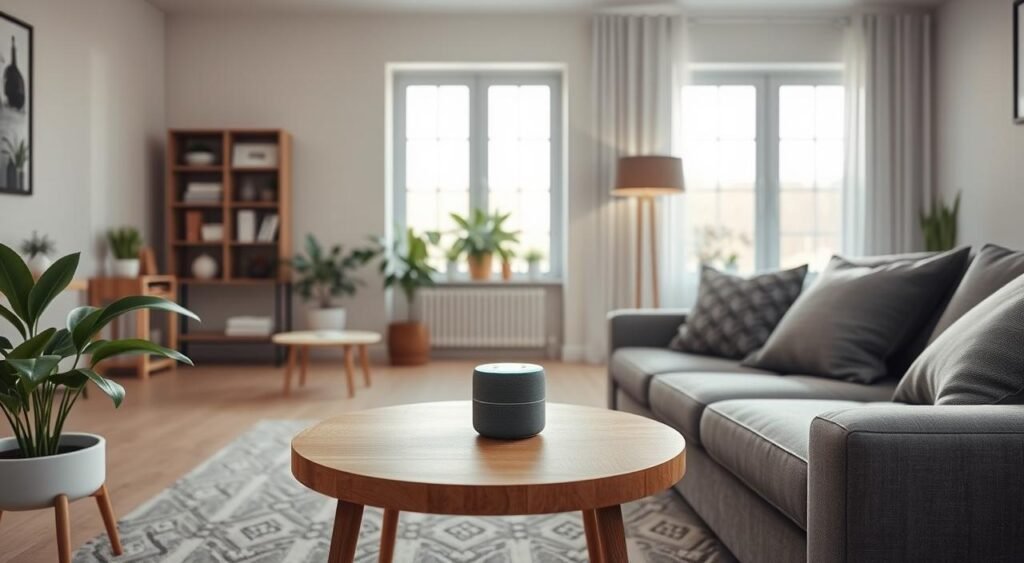
These assistants don’t just answer questions—they manage your home 24/7. Set routines like “Good Morning” to turn on lights and read the news. Use voice commands to lock doors via Wyze Lock or adjust Wyze Bulbs’ color temperature.
Even the $19 Echo Dot on sale can control your entire system! Pair voice devices with Tapo C120 cameras for local storage security—all without breaking the bank.
Remember: voice assistants thrive when connected to your existing setup. Lutron Aurora switches work with all three major platforms, so you can dim lights hands-free. And don’t miss holiday sales—Amazon regularly drops Echo Dots to under $20. With these tools, your voice becomes the ultimate remote control, turning any home into a high-tech hub without luxury pricing.
Making Existing Appliances “Smart” Without Replacing Them
Smart home upgrades don’t mean you have to get rid of your old appliances—budget-friendly home automation is all about what you already have. Think about turning your coffee maker into an alarm clock or getting a notification when the laundry is done—all without spending a fortune. Let’s explore some affordable ways to upgrade your home.
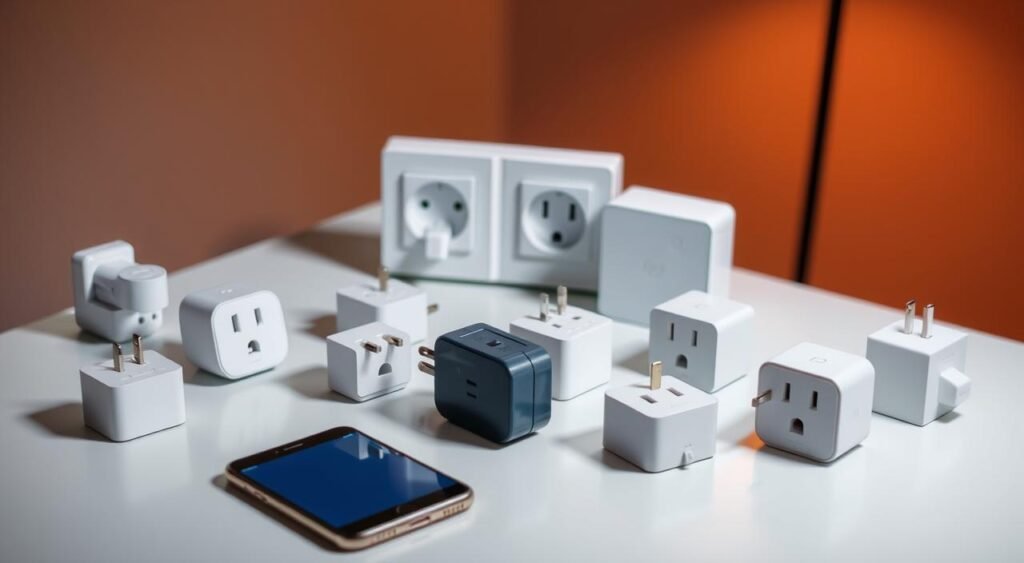
Smart plugs are a top choice for quick upgrades. Brands like Sonoff offer plug-and-play solutions for under $50. Just plug one into an outlet, connect it to your phone, and your desk lamp becomes a timer-controlled nightlight or your space heater adjusts to your schedule. No need to buy new devices—just add smart control layers.
- Sonoff Smart Plugs: Control lamps, fans, or holiday lights via Wi-Fi.
- Broadlink RM Mini: Use IR blasters to turn old TVs or AC units into voice-responsive gadgets.
- Vibration Sensors: Attach to washing machines to send alerts when cycles finish—no more guessing!
Sensors also open up new possibilities. Door/window sensors from IKEA or Philips Hue can monitor deliveries at your mailbox or alert you when the garage door opens. Even motion sensors under $20 can turn your dumb floor lamp into a security tool that lights up when you walk by.
Forget about expensive replacements. With these tricks, budget-friendly home automation lets you future-proof your home without breaking the bank. Start small—add a smart plug to your kettle or lamp today. Every upgrade brings you closer to a smarter, connected space without the financial strain!
Free and Low-Cost Automation Software Tools
Transform your devices into a seamless smart system without breaking the bank. The right software can turn basic gadgets into automation powerhouses. Explore tools that let you program, connect, and control everything—from lighting to security—at zero to minimal cost.
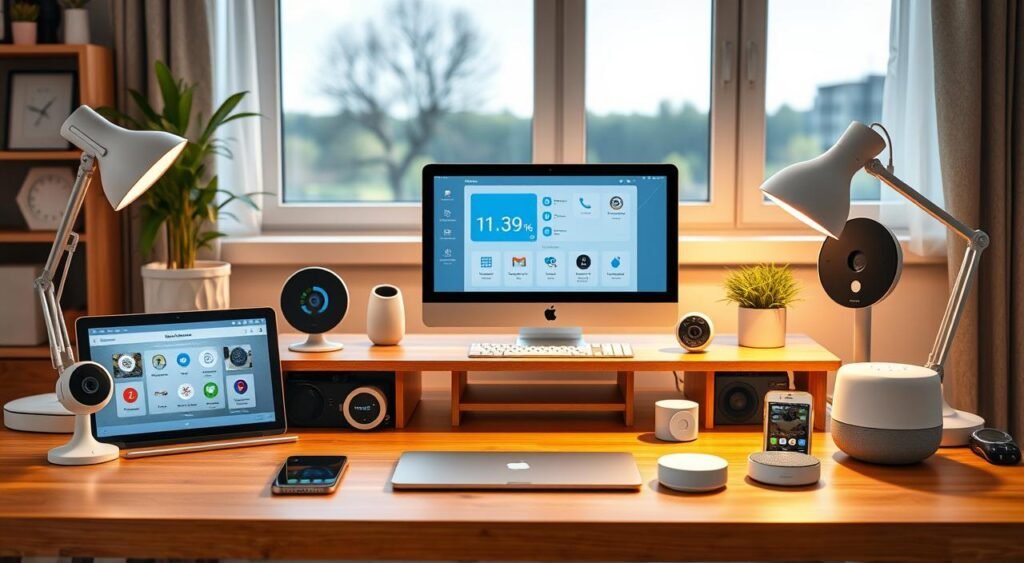
- Home Assistant: This free, open-source platform lets you create custom routines. Control lights, track energy use, and sync devices—all on your terms. No monthly fees!
- IFTTT (If This Then That): Start with the free tier to link Philips Hue bulbs to weather sensors. The $35/year plan unlocks advanced sequences without locking you into one brand.
- Node-RED: Drag-and-drop programming for non-coders. Turn voice commands into actions—like turning on coffee makers at sunrise—using your existing gadgets.
- OpenHAB: Another free platform with plugins for every budget device. Perfect for linking budget-friendly sensors to your router or Raspberry Pi.
Your smartphone can become a hub! Apple users love Shortcuts for quick tasks, while Android fans save with Macrodroid ($7 unlock fee). These tools work with existing hardware, so you don’t need to buy new devices.
Forget overpriced subscriptions. Platforms like Make (ex-Integromat) offer 2 free automation scenarios—ideal for starters. And don’t miss Raspbian OS, the free Raspberry Pi OS that turns $35 hardware into a full automation server.
Pairing these tools with smart plugs or sensors unlocks possibilities you’d expect from luxury systems. The key? Start small. Free tiers and open-source options give you the power to grow your setup as your budget allows.
Common Mistakes When Building a Smart Home on a Budget
Embarking on a smart home project on a budget is thrilling, yet pitfalls can quickly turn it into a challenge. I’ve identified common errors that homeowners often make. First, it’s essential to verify device compatibility. Even the most economical smart home devices won’t integrate seamlessly if they’re not compatible with your current setup.
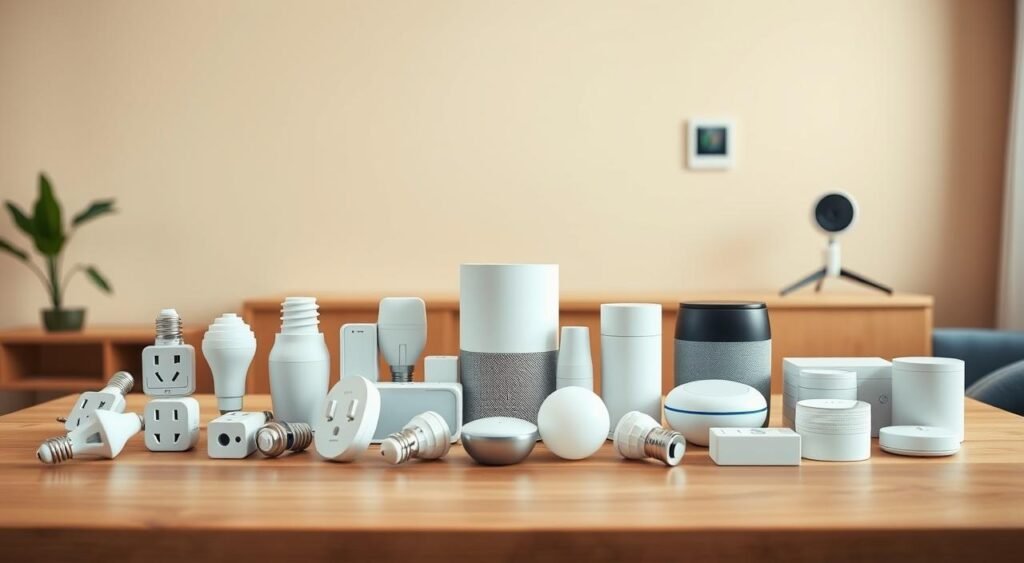
- Ignoring Protocol Conflicts: Devices using Wi-Fi, Zigbee, or Z-Wave may not communicate without a central hub. A hub like Samsung SmartThings or Apple HomeKit can bridge the gap between systems.
- Skipping Ecosystem Research: Devices compatible with Google Home or Alexa can save you time. Opt for gadgets that fit into your preferred ecosystem, unless you’re ready to switch.
- Overlooking Firmware Updates: Neglecting software updates can render even budget-friendly devices useless. Choose brands like Philips Hue or TP-Link, known for their regular updates to their economical smart home devices.
Avoiding Compatibility Issues Between Budget Devices
Ensuring compatibility is critical. Before making a purchase, consider the following:
| Check Before Buying | Why It Matters |
|---|---|
| Works with my router? | Old routers can struggle with multiple connected devices |
| Compatible with my voice assistant? | Most devices work with Google Home and Alexa, but double-check |
| Requires a hub? | Zigbee devices need a hub to function—plan ahead |
The False Economy of Ultra-Cheap Devices
While affordability is attractive, it’s not always the best value. Here’s why:
- Short warranties (or none at all)
- Limited app support or customer service
- Hidden costs like subscription fees
Opt for brands like IKEA TRÅDFRI or Wyze, which offer affordability without sacrificing reliability. Steer clear of unknown brands with no user feedback. Investing in devices that stand the test of time is worth the extra effort.
When to Splurge vs. When to Save in Home Automation
Ever ponder where to cut costs and where to invest in your smart home? A clear strategy can help navigate this. cheap home automation technology can be effective, but only if you focus on the right areas.
- Save on:
– Smart bulbs ($20-$100) – budget options shine just as bright as pricier models
– Basic security cameras ($25-$350) – entry-level picks offer solid protection
– Voice assistants – Alexa/Google Nest basics work as well as premium versions - Splurge on:
– Smart locks ($150-$400) – security deserves no compromises
– Thermostats ($150-$300) – better models save 10-15% on energy yearly
– Outdoor security – invest in reliable doorbells/cameras for long-term peace of mind
My golden rule? Always wait for the second generation of new tech – let early adopters work out the bugs first!
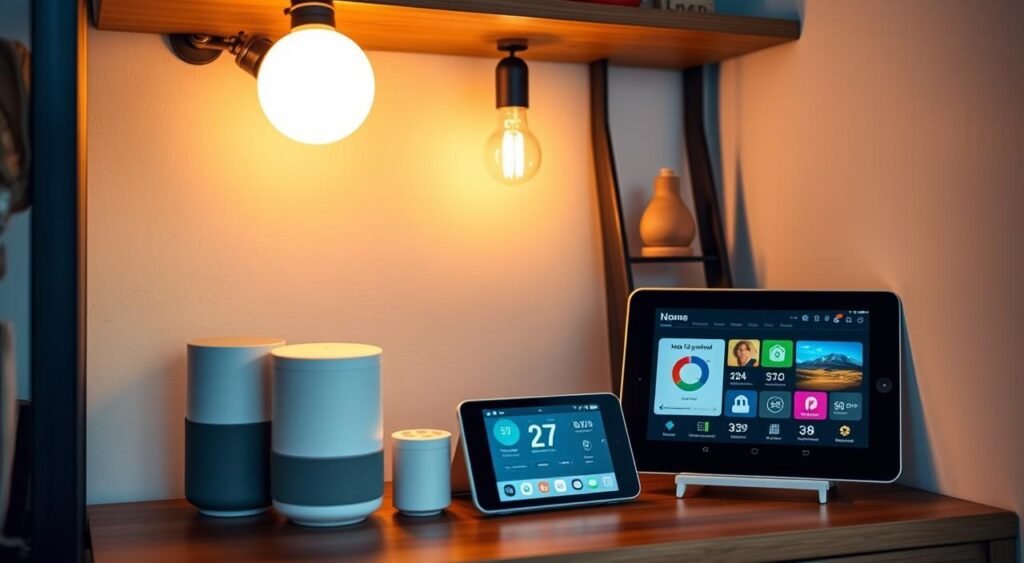
Remember, a $100 thermostat saving now could cost you $500 over five years in energy waste. Seek out cheap home automation technology that fulfills essential needs. Never compromise on security or energy management. Need help prioritizing? Start with my checklist: Does this device impact safety, energy bills, or daily convenience? Prioritize those first. Every dollar spent strategically today builds a smarter home for tomorrow!
Future-Proofing Your Budget Smart Home System
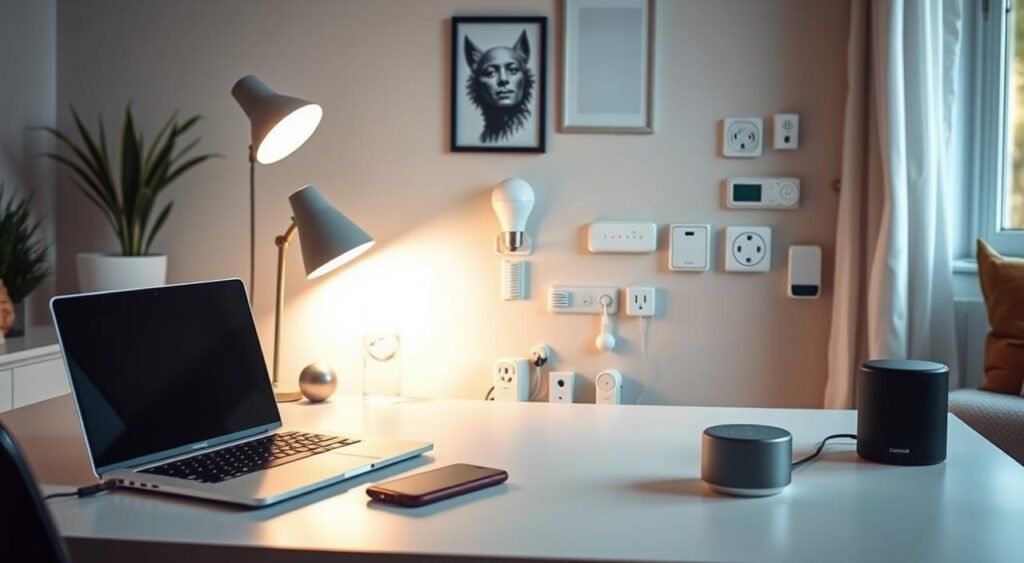
Starting small is wise, but how do you avoid obsolescence? We’ll explore steps to build a system that evolves with your budget and technology. This ensures your choices today won’t seem outdated tomorrow.
Begin with cost-effective home automation hubs that support various protocols like Zigbee, Z-Wave, or Matter. Opt for brands such as Samsung SmartThings or Philips Hue hubs. These allow for gradual device additions without needing a complete system overhaul.
Here’s what works:
- Choose ecosystems like Amazon Alexa or Google Home for seamless expansion
- Stick to open standards like Matter for cross-brand compatibility
- Invest in modular devices—think smart plugs or sensors you can expand over time
| Protocol | Strengths | Use Case |
|---|---|---|
| Zigbee | Low power, mesh networking | Lighting, sensors |
| Z-Wave | Reliable security, long-range | Locks, security systems |
| Matter | Cross-platform compatibility | Future-proof hubs/devices |
Ready to plan ahead? Begin with essential devices like smart bulbs or thermostats. These are the foundation for future upgrades. Budgeting smartly means avoiding dead-ends. Choose devices with over-the-air updates, like Philips Hue’s firmware upgrades, for longevity.
Emerging tech like AI-driven energy analytics or solar-integrated systems will soon be more affordable. Don’t wait for these innovations to start. Begin today with choices that scale. Your smart home can evolve gracefully without financial strain!
Conclusion: Creating Your Affordable Smart Home Journey
Creating a smart home doesn’t need to drain your wallet. Affordable options like Philips Hue bulbs under $10 or Ikea’s SYMFONISK speakers show that smart tech can be budget-friendly. Begin with a smart plug, a motion sensor, or a voice assistant. Each addition enhances your home’s functionality.
Choose gadgets that address real needs, such as energy savings or streamlining daily tasks. Home Assistant allows you to integrate Zigbee and Wi-Fi devices, balancing cost and functionality. Renters can also participate with adhesive mounts and modular systems. Over 1,000 affordable smart home solutions work with Google Home, from $15 smart locks to motion-activated lights. DIY projects and open-source platforms keep costs low while boosting your home’s intelligence.
Start with essential items like Philips and IKEA lighting, then expand with smart plugs or sensors. Celebrate small victories, like saving on energy bills or saving time with voice commands. Budget-friendly smart home solutions adapt to your pace—no need for instant perfection. Replace devices gradually as tech improves or needs change.
Begin with a smart bulb or thermostat, then let your system grow. Share your progress with the community—your setup might inspire others! With brands like Philips and Philips’ SYMFONISK, open standards like Zigbee, and free tools like Home Assistant, your smart home evolves at your speed. The future is flexible, accessible, and packed with possibilities—all within reach of any budget.
FAQ
How can I start my home automation journey on a budget?
Begin by identifying which features will make your daily life better. Opt for affordable options like smart plugs or budget-friendly smart lighting. Plan your upgrades in phases to manage costs over time.
What are some affordable smart home devices I should consider?
Explore economical smart home devices such as Wyze, Kasa, and Sengled smart bulbs. Also, consider budget smart home hubs like Echo Dots and Google Nest Minis. These offer great functionality without a high price tag.
Are there any DIY projects I can try to automate my home on a budget?
Yes! Try weekend DIY projects like automated lighting for under . You can also repurpose old smartphones as security cameras. No-code automation platforms make these projects easy to implement.
How can I ensure my smart home devices are compatible?
Ensure compatibility before buying new devices. Look for Z-Wave or Zigbee support. Use a compatibility checklist to ensure smooth integration with your system.
What are the hidden costs associated with cheap home automation technology?
Some budget systems have hidden costs like cloud storage fees or subscription services. These can erode initial savings over time. Always consider these costs when budgeting for home automation.
How can I maximize energy savings with my smart home devices?
Use smart thermostats, automated lighting schedules, and energy monitoring smart plugs to cut energy bills. Invest in devices with programming capabilities, like thermostats with geofencing.
What should I keep in mind when planning my smart home upgrade?
Implement your smart home in phases, focusing on convenience and efficiency. Document your progress to track energy savings and daily life improvements.
Is voice control a necessary feature in a budget smart home?
Voice control is not essential but enhances the automation experience. Affordable options like Amazon Echo and Google Nest can integrate your smart home at minimal cost.
Can I automate existing appliances without replacing them?
Yes! Smart plugs can turn ordinary appliances into smart devices. They offer scheduling and remote control without the need for new equipment.
How do I ensure my home automation system remains valuable over time?
Future-proof your smart home by choosing devices that support current protocols. Explore modular solutions for gradual expansion. Keep an eye on emerging technologies for better features at lower prices.
